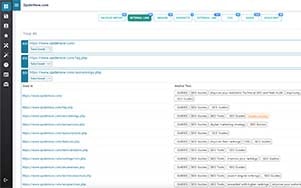What is site navigation, and why is it important for websites?
Site navigation refers to the system of menus, links, and other navigational elements that help users move between different pages and sections of a website. It is important for websites because it provides a roadmap for visitors to explore content, find information, and complete desired actions, such as making a purchase or contacting the business. Effective site navigation enhances user experience, improves usability, and increases engagement, ultimately leading to higher conversion rates and business success.
Enhancing User Experience through Effective Website Navigation
Effective website navigation is essential for enhancing user experience. It involves designing navigation menus and elements that are intuitive, easy to understand, and accessible to all users.
One key aspect of effective website navigation is simplicity. Keeping the navigation menus clean and uncluttered helps users focus on the main content of the website. Avoid overwhelming users with too many options or complicated navigation structures.
Furthermore, responsive design plays a crucial role in enhancing user experience on mobile devices. Ensure that your website's navigation is optimized for different screen sizes and devices to provide a seamless experience for mobile users.
By implementing effective website navigation strategies, you can significantly improve user experience, increase engagement, and drive conversions.
How does site navigation impact website rankings and overall user experience?
Site navigation impacts website rankings and overall user experience positively by:
1. Improved Crawling and Indexing: Clear navigation helps search engine crawlers discover and index your website's content more efficiently, leading to better visibility and rankings in search engine results pages (SERPs).
2. Enhanced User Satisfaction: Intuitive navigation reduces friction and frustration for users, allowing them to find what they're looking for quickly and easily, leading to higher satisfaction and retention rates.
3. Increased Engagement: Easy-to-use navigation encourages users to explore more pages and interact with your content, leading to higher engagement metrics such as time on site, pageviews, and conversion rates.
4. Higher Conversions: Effective site navigation guides users to key pages or conversion points, streamlining the user journey and increasing the likelihood of conversions and goal completions.
Optimizing Navigation Menus for Easy Access
Optimizing navigation menus is crucial for providing easy access to website content. Here are some tips to optimize navigation menus:
- Limit the number of menu items: Having too many menu items can overwhelm users and make navigation more difficult. Keep the menu concise and include only the most important sections.
- Use dropdown menus: If you have a large number of pages or subcategories, consider using dropdown menus to organize the content and make it easily accessible.
- Group related items: Organize menu items into logical groups based on their relevance and similarity. This helps users quickly find the section they are looking for.
- Provide clear labels: Use descriptive and concise labels for menu items to clearly communicate the purpose of each section.
- Use visual cues: Add visual cues such as arrows or icons to indicate submenus or expandable sections. This helps users understand the hierarchy of the navigation menu.
By optimizing navigation menus for easy access , you can improve the overall usability of your website and help users find the content they need more efficiently.
Implementing Breadcrumbs for Seamless Navigation
Implementing breadcrumbs is an effective way to enhance navigation and provide a seamless user experience. Breadcrumbs are a secondary navigation aid that shows users the path they have taken to reach the current page.
Breadcrumbs typically appear near the top of a webpage and provide clickable links to previous pages or categories. They help users understand the website's structure and easily navigate back to higher-level pages without relying solely on the back button.
By implementing breadcrumbs, you can improve the overall navigation experience, reduce user confusion, and enhance the usability of your website.
Testing and Improving Navigation for Better User Engagement
Testing and improving navigation is an ongoing process that can lead to better user engagement and satisfaction. By analyzing user behavior and making data-driven improvements, you can optimize your website's navigation to meet the needs and preferences of your target audience.
Here are some methods to test and improve navigation:
- A/B testing: Create different versions of your navigation and test them against each other to see which version performs better in terms of user engagement metrics.
- User feedback: Collect feedback from users through surveys, interviews, or usability testing sessions. This can provide valuable insights into any pain points or areas of improvement in your website's navigation.
- Analytics tracking: Monitor user behavior using analytics tools to identify any usability issues or bottlenecks in the navigation flow. Look for high bounce rates, low time spent on pages, or high drop-off rates at specific points in the navigation.
By regularly testing and improving your website's navigation, you can create a seamless user experience, increase user engagement, and ultimately drive better results for your website.










